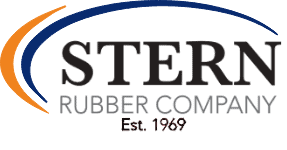Rubber To Metal Bonding
Bonding rubber to metal or other substrates, is a process that is our backbone at Stern Rubber Company, and is done at both of our facilities in Staples, Minnesota, and Aitkin, Minnesota. The term rubber to metal bonding is a generic phrase that employs the process of chemically bonding an elastomer to a pre-coated steel surface. Three elements create the bases of the bonding process, the rubber selected, the bonding agent and the substrate of metal.
Choosing a rubber to be bonded to metal is narrowed to how the final part is to be used, that is what kind of environment the rubber to metal part will be subjected to. Considerations need to be reviewed for UV light, exposure to grease, gasoline, chlorine, heat, cold, chemicals and many more. Stern Rubber Company can assist with the selection of a suitable rubber.
The metal insert is another key ingredient to the process; first the metal insert needs to be cleaned and degreased, getting the insert completely dry is the next step in the application. The next step is to apply a primer coat to the insert, followed by another drying application, and finally, bonding agent is applied and finished off by completely drying the final coat. Once the metal insert has the bonding agent applied to part, it can be over molded with the selected rubber and vulcanized. At Stern Rubber Company, we use a proprietary metal treatment process to prepare the substrates for the bonding agent. We apply the bonding agent used at our facility in Staples, by dipping the insert, pneumatically spraying over the part, or by painting the inserts by hand. Using our stringent controls to carefully monitor the thickness of the film of bonding agent being applied to the insert, this insures that our bonding process meets our customers’ demands and we produce quality rubber parts.
Just like science, the vulcanization of the chemical bond occurs simultaneously with the cure of the rubber elastomer, thus the bonding agents are designed to specifically react with the rubber’s process under the right conditions. Stern Rubber Company achieves maximum bond strength which is obtained under pressure inside the mold cavities. Our processes of compression molding, transfer molding and injection molding all work to create a solid bond between the metal and the rubber part. While there is an application for rubber to metal bonding of inserts into rubber extruded parts, the process is called co-extrusion and used in automotive industry for seals around windows.
Some of the rubber to metal bonded parts that we create at Stern Rubber Company for our customers are gate valves used in the water industry, isolators to reduce vibration, mounting bracket for engines and much more. Stern Rubber Company can also bond rubber to other substrates which includes other rubbers, plastic, cables, fiberglass, cords of nylon, rayon or Kevlar materials and various metals such as aluminum, steel, iron or aluminum castings.
Give Stern Rubber a call if you need help with a project that needs to have rubber bonded to metal or some other substrate.
